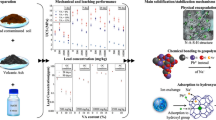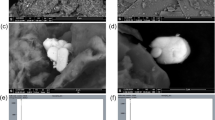Abstract
The adsorption of three humic acid (HA) preparations by clays—montmorillonite (Wyoming, USA) and palygorskite (Kolomenskoe district, Moscow oblast)—has been studied. The HA preparations were isolated from samples of the humus-accumulative horizons of a leached chernozem (Voronezh) and a chestnut soil (Volgograd), and a commercial preparation of sodium humate (Aldrich) was also used. The solid-state 13C NMR spectroscopy and IR spectroscopy revealed the selective adsorption of structural HA fragments (alkyls, O-alkyls (carbohydrates), and acetal groups) on these minerals. As a result, the aromaticity of the organic matter (OM) in the organic-mineral complexes (OMCs) and the degree of its humification have been found to be lower compared to the original HA preparations. The fractionation of HAs is controlled by the properties of the mineral surfaces. The predominant enrichment of OMCs with alkyls has been observed for montmorillonite, as well as an enrichment with O-alkyls (carbohydrates) for palygorskite. A decrease in the C : N ratio has been noted in the elemental composition of the OM in complexes, which reflected its more aromatic nature and (or) predominant sorption of N-containing structural components of HA molecules. The adsorption of HA preparations by montmorillonite predominantly occurs on the external surface of mineral particles, and the interaction of nonpolar alkyl groups of HAs with this mineral belongs to weak (van der Waals, hydrophobic) interactions. The adsorption of HA preparations by palygorskite is at least partly of chemical nature: Si-OH groups of minerals are involved in the adsorption process. The formation of strong bonds between the OM and palygorskite explains the long-term (over 300 million years) retention of fossil fulvate-type OM in its complex with palygorskite, which we revealed previously.
Similar content being viewed by others
References
L. N. Aleksandrova, Soil Organic Matter and the Processes of Its Transformation (Nauka, Leningrad, 1980) [in Russian].
T. V. Alekseeva, P. B. Kabanov, B. N. Zolotareva, A. O. Alekseev, V. A. Alekseeva, “Humic substances of the Late Carboniferous palygorskitic paleosol from the southern Moscow region, Russia,” Dokl. Biol. Sci. 425, 128–132 (2009).
T. V. Alekseeva, B. N. Zolotareva, and Yu. G. Kolyagin, “Fractionation of humic acids by clay minerals assayed by 13C-NMR spectroscopy” Dokl. biol. Sci. 434, 341–346 (2010).
T. V. Alekseeva, Z. Sokolowska, M. Hajnos, A. O. Alekseev, and P. I. Kalinin, “Water stability of aggregates in subtropical and tropical soils (Georgia and China) and its relationships with the mineralogy and chemical Properties,” Eur. Soil Sci. 42(4), 415–425 (2009).
D. A. Bushnev, N. S. Burdel’naya, M. V. Mokeev, and A. V. Gribanov, “Chemical structure and 13C NMR spectra of the kerogen of carbonaceous rock masses,” Dokl. Earth Sci. 430, 210–213 (2010).
V. A. Demkin, Paleopedology and Archaeology: Integration in the Study of Nature and Society (ONTI PNTs RAN, Pushchino, 1997) [in Russian].
A. G. Zavarzina and V. V. Demin, “Interaction of humic acids of different origins with soil minerals,” Proc. of the V All-Russia Conf. Humic Substances in the Biosphere (St. Petersburg, 2010), pp. 242–249 [in Russian].
T. A. Zubkova and L. O. Karpachevskii, The Matrix Organization of Soils (Rusaki, Moscow, 2001) [in Russian].
D. V. Kovalevskii, Investigation of the Structure of Humic Acids by 1H and 13 C NMR methods, Cand. Sci. (Chemistry) Diss. (1998) [in Russian].
D. S. Orlov, Soil Chemistry (Izd. Mosk. Gos. Univ., Moscow, 1985) [in Russian].
D. S. Orlov and L. A. Grishina, Practicum on Humus Chemistry (Izd. Mosk. Gos. Univ., Moscow, 1981) [in Russian].
D. S. Orlov and N. N. Osipova, Infrared Spectra of Soils and Soil Components (Izd. Mosk. Gos. Univ., Moscow, 1988) [in Russian].
T. A. Sokolova and S. Ya. Trofimov, Sorption Properties of Soils. Adsorption. Cation Exchange (Universitetskaya kniga, Moscow, 2009) [in Russian].
L. S. Travnikova and N. A. Titova, “Factors regulating distribution of organic substances by fractions <5 μm in solonetzic soil complexes of Kalmykia,” Pochvovedenie, No. 11, 109–121 (1978).
D. V. Khan, Organomineral Compounds and Soil Structure (Nauka, Moscow, 1969) [in Russian].
V. A. Kholodov, A. I. Konstantinov, and I. V. Perminova, “The carbon distribution among the functional groups of humic acids isolated by sequential alkaline extraction from gray forest soil,” Eur. Soil Sci. 42(11), 1229–1233 (2009).
F. V. Chukhrov (Ed.), Mineral. Reference Book, Vol. IV, Iss. 2 (Nauka, Moscow, 1992).
T. Alekseeva, P. Besse, F. Binet, A. M. Delort, C. Forano, N. Josselin, M. Sancelme, C. Tixier, “Effect of earthworm activity (Aporrectodea giardi) on atrazine adsorption and biodegradation,” Eur. J. Soil Sci. 57, 295–307 (2006).
J. A. Baldock, J. M. Oades, A. G. Waters, X. Peng, A. M. Vassallo, M. A. Wilson, “Aspects of the chemical structure of soil organic materials as revealed by solid-state 13C NMR spectroscopy,” Biogeochemistry 16, 1–42 (1992).
X. Feng, A. J. Simpson, and M. J. Simpson, “Chemical and mineralogical controls on humic acid sorption to clay mineral surfaces,” Organic Geochem. 36, 1553–1566 (2005).
S. Ghosh, Z. Y. Wang, S. Kang, P. C. Bhowmik, and B. S. Xing, “Sorption and fractionation of a peat derived humic acid by kaolinite, montmorillonite, and goethite,” Pedosphere 19(1), 21–30 (2009).
V. Gionis, G. H. Kacandes, I. D. Kastritis, and G. D. Chryssikos, “On the structure of palygorskite by mid- and near-infrared spectroscopy,” Am. Mineral. 91, 1125–1133 (2006).
C. Hinz, “Description of sorption data with isotherm equations,” Geoderma 99(3–4), 225–244 (2001).
B. Hubbard, W. Kuang, A. Moser, G. A. Facey, C. Detellier, “Structural study of Maya blue: textural, thermal and soild-state multinuclear magnetic resonance characterization of the palygorskite-indigo and sepiolite-indigo adducts,” Clays Clay Mineral. 51((3)), 318–326 (2003).
C. Keeler, E. F. Kelly, and G. E. Maciel, “Chemical-Structural Information from Solid-State 13C-NMR studies of a suite of humic materials from a Lower Montane forest soil, Colorado, USA,” Geoderma 130, 124–140 (2006).
M. Kleber, P. Sollins, and R. Sutton, “A conceptual model of organo-mineral interactions in soils: self-assembly of organic molecules fragments into zonal structures on mineral surfaces,” Biogeochemistry 85, 9–24 (2007).
I. Kogel-Knabner, G. Guggenberger, M. Kleber, E. Kandeler, K. Kalbitz, S. Scheu, K. Eusterhues, and P. Leinweber, “Organo-mineral associations in temperate soils: intergrating biology, mineralogy, and organic matter chemistry,” J. Pl. Nutr. Soil Sci. 171, 61–82 (2008).
W. Kuang, G. A. Facey, and C. Detellier, “Dehydrations and rehydration of palygorskite and the influence of water on the nanopores,” Clays Clay Mineral. 52(5), 635–642 (2004).
D. A. Laird, D. A. Martens, and W. L. Kingery, “Nature of clay-humic complexes in an agricultural soil: I. Chemical, biochemical, and spectroscopic analyses,” Soil Sci. Soc. Am. J. 65, 1413–1418 (2001).
J. Leifeld and I. Kogel-Knabner, “Organic carbon and nitrogen in fine soil fractions after treatment with hydrogen peroxide,” Soil Biol. Biochem. 33, 2155–2158 (2001).
J. Leifeld and I. Kogel-Knabner, “Soil organic matter fractions as early indicators for carbon stock changes under different land use?,” Geoderma, 124, 143–155 (2005).
M. V. Luetzow, I. Kogel-Knabner, K. Ekschmitt, E. Matzner, G. Guggenberger, B. Marshner, and H. Flessa, “Stabilization of organic matter in temperate soils: mechanisms and their relevance under different soil conditions,” Europ. J. Soil Sci. 57, 426–445 (2006).
M. V. Luetzow, I. Kogel-Knabner, K. Ekschmitt, H. Flessa, G. Guggenberger, E. Matzner, and B. Marshner, “SOM fractionation methods: relevance to functional pools and to stabilization mechanisms,” Soil Biol. Biochem. 39, 2183–2207 (2007).
R. Mikutta, K. Kaiser, N. Dörr, A. Vollmer, O. A. Chadwick, J. Chorover, M. G. Kramer, and G. Guggenberger, “Mineralogical impact on organic nitrogen across a long-term soil chronosequence (0.3–4100 kyr),” Geochim. Cosmochim. Acta 74(7), 2142–2164 (2010).
J. Neidhardt, K. Eusterhues, A. Hadrich, K. Küsel, T. Rennert, I. Kögel-Knabner, and K. Totsche, “Composition and biodegradation of ferrihydrite-associated soil organic matter studied by 13C-NMR, FTIR, and incubation experiments,” in Advanced Spectroscopic and Microscopic Characterisation Techniques-Tools to Enlighten Biogeochemical Interfaces in Soil (Jena, 2010).
H. Quiquampoix and R. G. Burns, “Interactions between proteins and soil mineral surfaces: environmental and health consequences,” Elements, 3, 401–406 (2007).
S. A. Quideau, M. A. Anderson, R. C. Graham, O. A. Chadwick, S. E. Trumbore, “Soil organic matter processes: characterization by 13C-NMR and 14C measurements,” Forest Ecol. Manag. 138, 19–27 (2000).
J. A. Rice, “Humin,” Soil Science 166(11), 848–857 (2001).
M. W. I. Schmidt, H. Knicker, P. G. Hatcher, and I. Kögel-Knabner, “Improvement of 13C and 15N CPMAS NMR spectra of bulk soils, particle size fractions and organic material by treatment with 10% hydrofluoric acid,” Eur. J. Soil Sci. 48, 319–328 (1997).
A. Singer and P. M. Huang, “Adsorption of humic acid by palygorskite and sepiolite,” Clay Miner. 24, 561–564 (1989).
A. J. Simpson, M. J. Simpson, W. L. Kingery, B. A. Lefebvre, A. Moser, A. J. Williams, M. Kvasha, and B. P. Kelleher, “The application of 1H high-resolution magic-angle spinning NMR for the study of clayorganic associations in natural and synthetic complexes,” Langmuir 22(10), 4498–4503 (2006).
A. J. Simpson and M. J. Simpson, “Nuclear magnetic resonance analysis of natural organic matter,” in Biophysico-Chemical Processes Involving Natural Nonliving Organic Matter in Environmental Systems (John Wiley & Sons, 2009).
R. S. Swift, “Organic matter characterization (Chapter 35),” in Methods of Soil Analysis, Part 3 (Soil Sci. Soc. Am., Madison, WI, 1996), pp. 141–163.
J. M. Tisdall and J. M. Oades, “Organic matter and water-stable aggregates in soils,” J. Soil Sci. 33, 141–163 (1982).
K. Wang and B. Xing, “Structural and sorption characteristics of adsorbed humic acid on clay minerals,” J. Environ. Qual. 34, 342–349 (2005).
A. G. Zavarzina, “A mineral support and biotic catalyst are essential in the formation of highly polymeric soil humic substances,” Eur. Soil Sci. 39(Suppl. 1), 548–553 (2006).
Author information
Authors and Affiliations
Additional information
Original Russian Text © T.V. Alekseeva, B.N. Zolotareva, 2013, published in Pochvovedenie, 2013, No. 6, pp. 658–671.
Rights and permissions
About this article
Cite this article
Alekseeva, T.V., Zolotareva, B.N. Fractionation of humic acids upon adsorption on montmorillonite and palygorskite. Eurasian Soil Sc. 46, 622–634 (2013). https://doi.org/10.1134/S106422931306001X
Received:
Published:
Issue Date:
DOI: https://doi.org/10.1134/S106422931306001X




